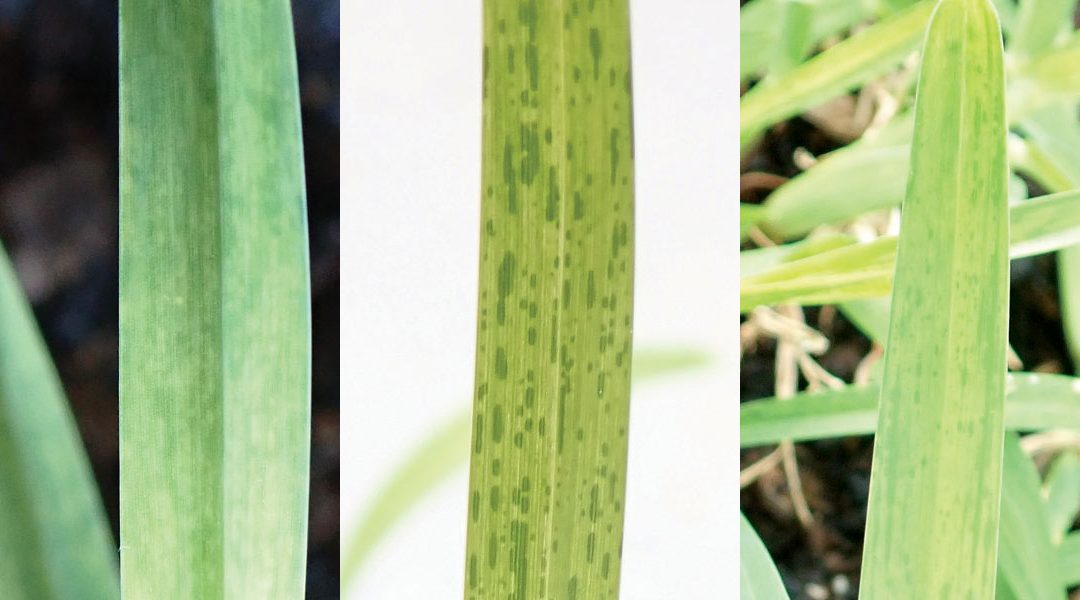Background
Buffalo Grass Yellowing has been observed on many turf farms around Australia and in a range of varieties. This yellowing fluctuates in severity and plants appear to recover at certain times of the year. Growers have reported that symptoms are non-responsive to fungicide applications but have been improved by more frequent but lower rates of nitrogen application. However, fertiliser applications have only temporarily disguised the symptoms, which have reappeared at a later date.
Buffalo Grass Yellowing is a very poorly understood disease syndrome and probably has multiple causes. Yellowing can be caused by nutrient deficiencies, which may be related to soil pH. In Western Australia, calcareous soils are thought to cause lime-induced chlorosis of Buffalo Grass. There are also a multitude of pest and pathogens that potentially could cause the yellowing, such as root-infecting fungi, viruses, nematodes and phytoplasmas.
In the 2018-19 summer, Buffalo Grass Yellowing was very prominent in the Hawkesbury and Hunter Valleys near Sydney, New South Wales, which led A/Prof Andrew Geering from the University of Queensland to have a closer look at the disease syndrome. Evidence for viral infections was found, which could help explain Buffalo Grass Yellowing on at least some farms. Worldwide, three viruses are known to cause disease in Buffalo Grass, and these are; Sugarcane Mosaic Virus (SMV), Johnsongrass Mosaic Virus (JGMV) and Panicum Mosaic virus (PMV), and all three occur in Australia.
This Fact Sheet has been compiled as a guide to assist growers concerned about Buffalo Grass Yellowing while the research industry awaits news from Hort Innovation on the approval of a significant project – Identification and management of mosaic viruses and secondary pathogens in Buffalo Turf (TU19000). It is important to emphasize that the first step in finding a management solution for Buffalo Grass Yellowing is to provide an accurate diagnosis, and to not jump to conclusions before the plants have been assessed by an expert.
PMV
Panicum mosaic virus
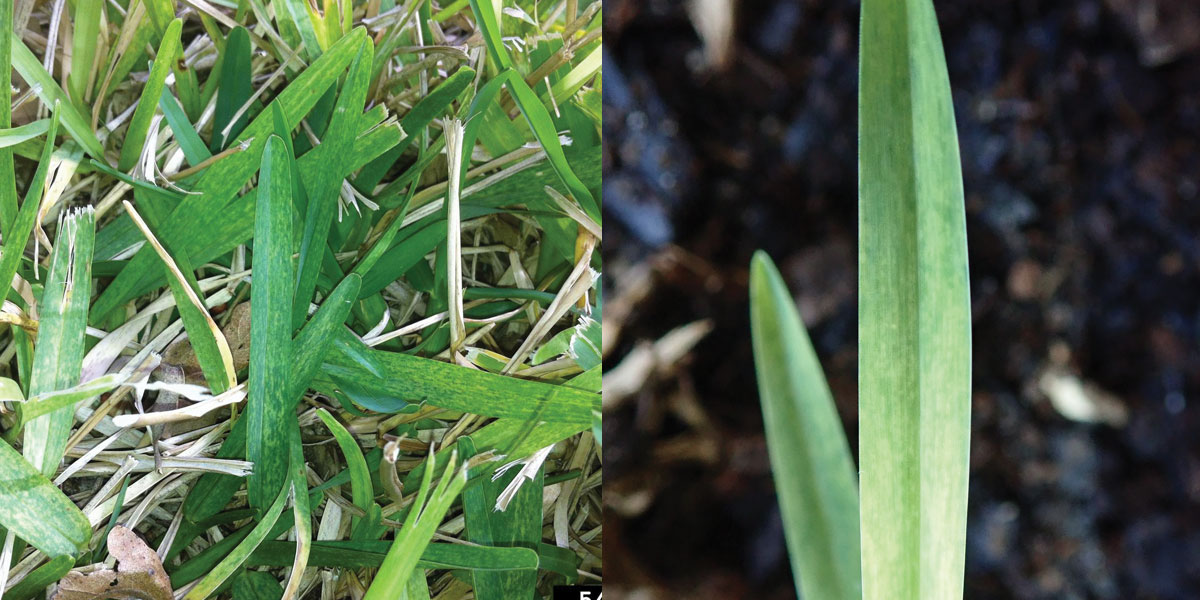
Figure 1. Panicum Mosaic Virus
Panicum Mosaic Virus (PMV) is thought to have originated in south-eastern United States of America (USA) and neighbouring Mexico, where it causes a serious disease of Buffalo Grass called St. Augustine Decline (SAD). PMV was first detected in Australia in 2011 in the Hawkesbury Valley, and this remains the only region where the virus has been found, although other states have not yet been surveyed. There are no chemical cures for PMV infection, and the best long-term control strategy is the use of resistant varieties such as ‘Floratam’, ‘Floralawn’, ‘Raleigh’ and ‘Seville’. Disease responses of local Australian varieties have not yet been tested.
Symptoms:
- Chlorotic (yellow) mottling or stippling of the leaf blades. These symptoms are mild and may go either unnoticed or be attributed to feeding damage from mites (Figure 1).
- As the disease progresses, infected leaves take on a general chlorotic appearance that resembles symptoms of iron or other nutrient deficiency.
- Lawns become less vigorous and begin to thin and weaken, which allows the establishment of weeds or other more vigorous turf grasses such as green couch. This thinning is exacerbated when the turf is grown in shade.
- Infection with PMV predisposes the plant to infection by other fungal pathogens.
Transmission:
- The virus is mechanically transmitted on the blades of mowers or edgers. Sap transmission is enhanced when the grass is wet.
- There are no insect vectors of PMV. Transmission is purely by mechanical means.
- PMV is spread over long distances in slabs of infected turf.
- PMV can survive in leaf debris for periods of several years. The contribution of leaf debris to virus outbreaks is unknown but the risk is probably small.
Host range:
- PMV has a narrow host range restricted to species in the Panicoidae subfamily of grasses. Different strains of PMV infect Switchgrass (Panicum virgatum) and Centipedegrass (Eremochloa ophiuroides), although these strains are not able to infect Buffalo Grass. Alternative hosts are probably not significant in the epidemiology of the SAD strain of PMV.
JGMV – Johnsongrass Mosaic Virus
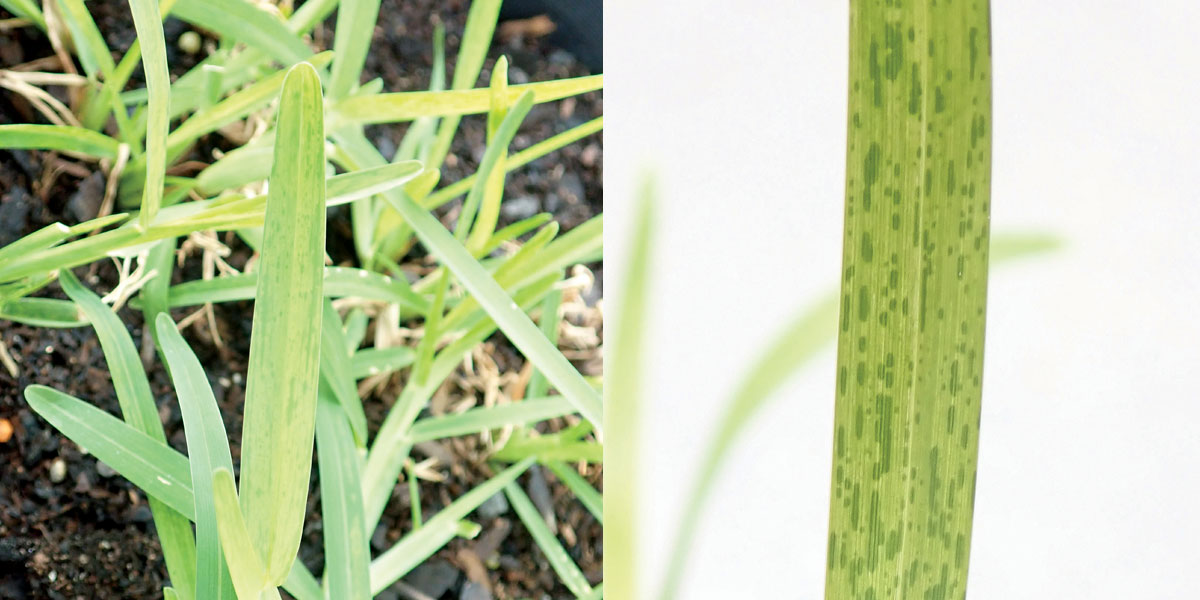
Figure 2. Johnsongrass Mosaic Virus
Johnsongrass Mosaic Virus (JGMV) has only been reported as a problem of Buffalo Grass in Australia and not the USA, even though JGMV is found in the USA in other grass hosts. From the limited surveying that has been done so far, JGMV is the most common viral pathogen of Buffalo Grass. JGMV takes its name from Johnsongrass (Sorghum halepense), a weedy relative of grain sorghum and one of the main hosts of the virus in Queensland.
JGMV has been present in Australia since at least the 1960s, although it was first recognized as a disease-causing agent of Buffalo Grass in the Hawkesbury Valley in 1990. JGMV is genetically very closely related to SCMV, has an almost identical biology, and for years before the adoption of nucleic acid sequencing technologies, was considered a strain of the latter.
To date, no work has been done on management of JGMV in Buffalo Grass within Australia, but in grain sorghum (S. bicolor), the virus is controlled by deployment of resistance genes and the clean-up of alternative weed hosts of the virus. Resistant genes against SCMV are sometimes the same as those against JGMV, so there are prospects that ‘Palmetto’ and ‘Bitterblue’ could provide a source of resistance for JGMV but this hypothesis still does need to be tested.
Symptoms:
Yellow mosaic patterns and mottles. The leaf goes yellow but with sharply contrasting islands of green, which would be the natural colour of the leaf (see Figure 2).
Leaf blades are narrower in width and plant growth is stunted.
Long term progression of the disease is unknown.
Transmission:
JGMV is transmitted by a broad range of aphid species and they are able to acquire and transmit the virus in a matter of 10 seconds feeding. There may not even be evidence of aphids colonizing the plants, the visitations are so brief.
It is likely that the viruses are transmitted on cutting blades in a manner similar to PMV.
JGMV is spread over long distances in slabs of infected turf.
Host range:
Sorghum halapense is the principal alternative host of JGMV in Australia.
Other natural grass hosts include Brachiaria miliiformis, B. praetervisa, Cenchrus ciliaris, Dinebra retroflexa, Echinochloa colona, E. crus-galli, E. frumentacea, Eragrostis cilianensis, Panicum miliaceum, Paspalum orbiculare, Pennisetum typhoideum, Setaria anceps, S. italica and S. verticillata.
SCMV
Sugarcane Mosaic Viru
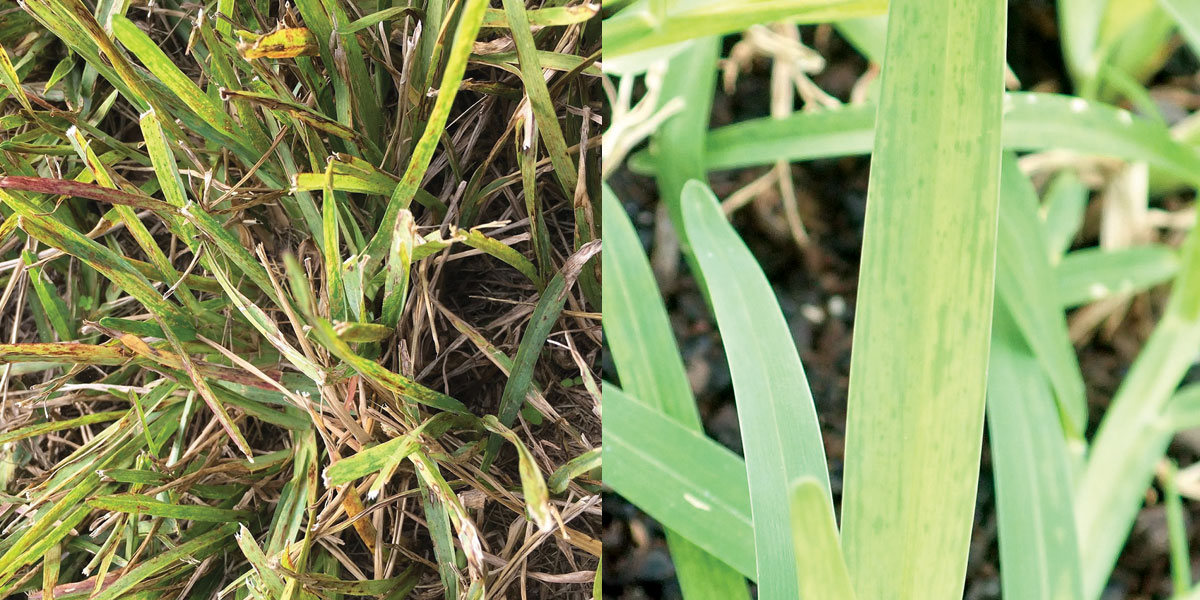
Figure 3. Sugarcane Mosaic Virus
Sugarcane Mosaic Virus (SCMV) is better known as a pathogen of sugarcane and maize. SCMV was once a serious pathogen of sugarcane crops in Queensland but has largely disappeared through deployment of resistant varieties. There is a strain of SCMV in Queensland Blue Couch (Digitaria didactyla) but this strain is considered to be restricted in nature to this plant species. There are no records of SCMV from Buffalo Grass in Australia, but it is a problem in the USA.
SCMV was once regarded as minor pathogen of Buffalo Grass in the sugarcane-growing regions of Florida, where it caused a mild leaf mottle. However, in 2013, there was an outbreak of a much more virulent strain of the virus in the neighbourhoods of St. Petersburg, Florida, which led to leaf mosaic patterns, severe dieback and completely killed some infected lawns.
More disease symptoms were observed in the variety ‘Floratam’ and conversely, ‘Palmetto’ and ‘Bitterblue’ were tolerant, but not immune, to infection. This strain of SCMV should be regarded as a serious biosecurity threat to the Australian turf industry.
The biology of SCMV is essentially the same as JGMV, and the two viruses can only be distinguished using molecular tests.
Management of plant viral diseases of buffalo grass
- Obtain an accurate diagnosis.
- There are no chemical cures for either PMV or JGMV. Once a plant is infected, it is infected for life. The virus moves systemically within the plant and infects new leaves and shoots as they emerge.
- Although JGMV is transmitted by aphids, the use of insecticides is not recommended as the aphids can transmit the virus in a matter of seconds, before the insecticide has a chance to kill the aphid.
- The best control is prevention – avoid introduction of the viruses in the first place and prevent spread through decontaminating mowing equipment and spot-spraying patches of diseased plants with a herbicide.
- Clean mowing equipment between paddocks with a high-pressure hose, steam or even better, a 1 per cent commercial bleach solution.
- Mow when dry.
- Eradicate weedy grasses along roadsides, particularly Johnsongrass (Sorghum halapense).
- Complete fertiliser and iron applications at the beginning of spring will improve the appearance of the turf but do not cure the disease.
- Plant disease resistance is the best long-term control strategy but information on resistance of local varieties is currently not available.
Diagnosis is first port of call
There are likely multiple causes of Buffalo Grass Yellowing. Virus infections can only be confirmed by laboratory tests. To confirm a virus diagnosis, growers can submit a sample to The University of Queensland.
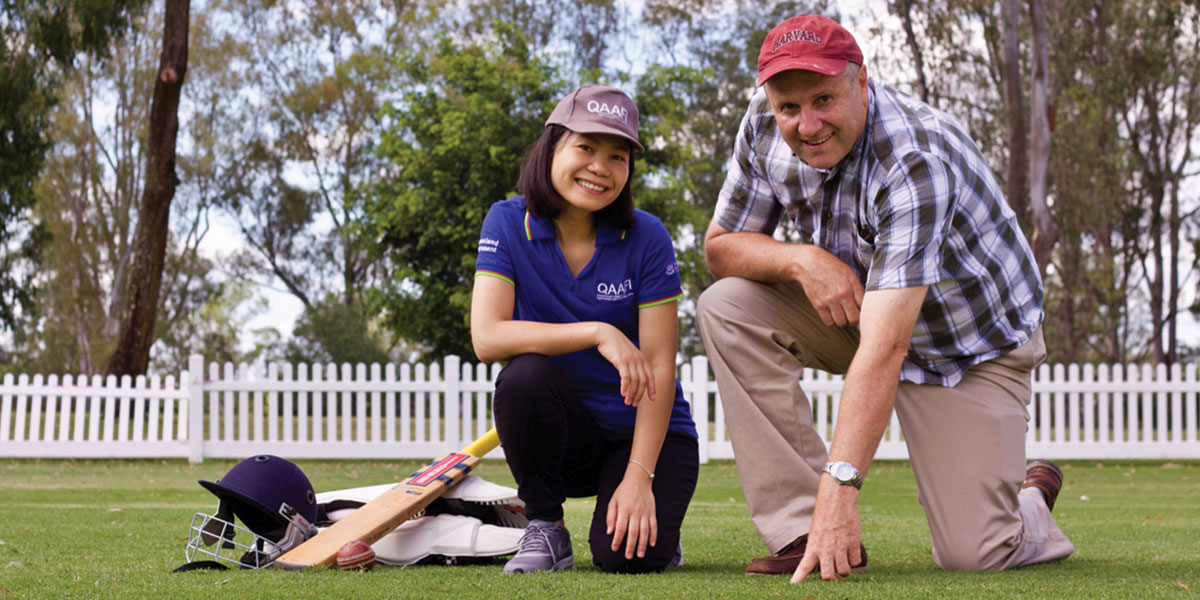 Above: Assoc. Prof Andrew Geering and Dr Nga Tran inspect the cricket oval at The University of Queensland.
Above: Assoc. Prof Andrew Geering and Dr Nga Tran inspect the cricket oval at The University of Queensland.
Virus testing service:
Turfgrass Sample Collection:
- Collect turf samples with early and advanced stages of disease development.
- Collect turf samples from transition zone between healthy and diseased turfgrass so samples contain both healthy and affected turf.
- Collect one to two representative samples from each problem area. Samples can be either “cup cutter” samples or a sample at least 6 x 6 inches in area.
- Completely dead turfgrass seldom generates an accurate diagnosis.
Turfgrass Sample Packaging:
- Wrap samples in newspaper or aluminium foil.
- Place samples in a sturdy cardboard box and pack securely.
- Do not add water to samples.
- Fill in a Turfgrass Sample Submission Form.
- Ship samples to the University of Queensland immediately after collection. Avoid sending after Thursday, so samples don’t sit over the weekend.
- Samples without the appropriate Sample Submission Form(s) and diagnostic fee(s) will not be processed.
- Start-up fee for the first sample is $150, and $80 for extra samples tested at the same time. These fees apply only to virus diagnostic services.
Turfgrass Sample Submission:
- Ship samples to correct mailing address.
- Ship samples early in the week.
- Samples should be delivered overnight (preferably via courier services).
- Samples will not be received on Saturdays, Sundays and holidays.
- Submission form can be found and completed on the website at https://www.daf.qld.gov.au/business-priorities/biosecurity/plant/health-pests-diseases/grow-help-australia-sample-submission-form
Sample Submission Address:
By Australia Post: Dr Andrew Geering, GPO Box 267, Brisbane QLD 4001.
By Courier: Dr Andrew Geering, Loading Bay Level B3 (off Joe Baker Street), Ecosciences Precinct, 41 Boggo Road, Dutton Park QLD 4102.
Important: Australia Post will not deliver to the street address.

